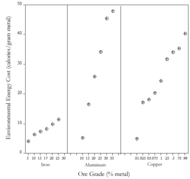Environmental energy cost
Environmental energy cost is the energy required to create a unit of a natural resource of a given concentration. The high concentration of energy and materials in natural resources is the result of work processes in the environment. Energy is required to produce a gradient, which is nothing more than a difference in the concentration of something compared to its average concentration. This means that energy is used to produce the high concentrations of fish, metals, and other energy and materials that form our natural resource base.
There are two sources of environmental energy: solar energy, and heat from the Earth’s interior. These energies power environmental processes such as wind, rain, tides, primary production, the sedimentary cycle, etc. that create and sustain natural resources. For example, heat energy from the Earth’s interior drives the crustal plates, uplifting mountain ranges that play a critical role in regional distribution of precipitation. That energy investment is part of the environmental energy cost of clean water produced by the hydrologic cycle. Solar energy and heat from the Earth's core drive the sedimentary cycle that produces the temperature and pressure necessary to transform and concentrate the carbon in dead plant material to a level many times its crustal abundance. This process creates oil and coal. Unique combinations of solar energy and ocean currents combine to concentrate energy and nutrients in zones of upwelling that support high concentrations of fish.
More environmental energy must be used to concentrate a resource further away from its average concentration. Higher-grade metal ores have much higher concentrations than their crustal abundance, and thus required significant environmental energy to create. For metals, this is reflected by the Gibbs free energy of formation for different ores (see Figure 1). For example, three times more energy in the environment is used to produce a gram of iron in a 30% ore compared to a 5% ore.
